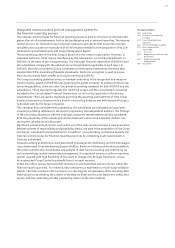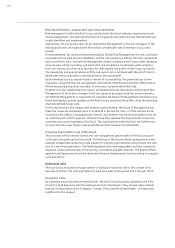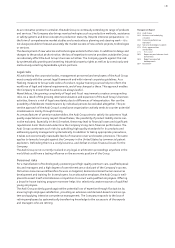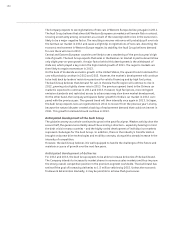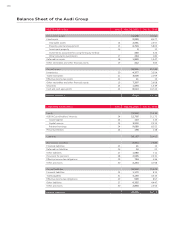Audi 2011 Annual Report Download - page 183
Download and view the complete annual report
Please find page 183 of the 2011 Audi annual report below. You can navigate through the pages in the report by either clicking on the pages listed below, or by using the keyword search tool below to find specific information within the annual report.
180
This change in the framework conditions is prompting more intense competition and the more
widespread use of sales incentives. The spread of such practices can fundamentally lead to price
erosion and inflated marketing costs, especially in the principal sales markets Europe, China and
the United States, and may ultimately filter through to the Audi Group’s revenue and profit per-
formance. There are also risks to revenue and profit from the price structures of direct competi-
tors, because the Audi brand will be unable to ignore a downward trend in the long term. State
subsidies for individual manufacturers or vehicle categories could distort competition, thereby
adversely affecting the profit performance of the Audi Group.
Growing pressure to improve fuel efficiency and cut vehicle emissions constitutes a major chal-
lenge for the automotive industry. As well as worldwide variation in the statutory requirements
such as CO₂ limits, heightened environmental awareness among customers is becoming an in-
creasingly significant factor. The increased sensitivity of customers to environmental acceptability
and fuel economy moreover means that a permanent shift in demand in individual markets
towards smaller cars cannot be excluded. However, the Audi Group is responding successfully to
such challenges by steadily reducing the consumption and emissions of its product range and
introducing compact models such as the Audi A1. An array of efficiency technologies already supply
ample evidence of the brand essence “Vorsprung durch Technik.” In addition to optimizing con-
ventional drive technologies, the Company is focusing its attention on researching alternative
fuels and new drive concepts. The Audi Group is moreover responding to its customers’ desire for
sustainable mobility through a systematic hybridization and electrification strategy.
Risks from operating activities
Through its operating activities the Audi Group is exposed to a number of risks that could adversely
affect its net worth, financial position and financial performance.
These include for instance unforeseeable events such as explosions and major fires which could
destroy or damage the Group’s assets, but also cause serious disruption to production processes.
There is also the risk of disruptions to production operations as a result of power supply failures
or technical failures, in particular of IT systems. Although the potential for losses from the
above risks is considerable, their probability is viewed as low. To reduce such risks, the Company
has implemented preventive measures such as fire protection systems, emergency plans and
company fire departments, and taken out adequate insurance cover. The Audi production net-
work’s high flexibility also envisages transferring production capacity to reduce the risks of lost
production.
Lasting disruption to the production process could also be caused by delayed delivery or non-
delivery as a result of tool breakage, losses from natural disasters and strikes at suppliers or in
the transportation sector. The Audi Group uses detailed selection, monitoring, steering and
supporting processes to minimize financial difficulties at dealers and suppliers that could in the
worst instance result in their bankruptcy.
Within the automotive industry there is close cooperation between manufacturers and suppliers,
possibly extending to the research and development sphere and other strategically significant
sections of the value chain. This partnership-based collaboration brings both economic advantages
and growing mutual dependence. The exclusive use of innovative technologies by suppliers with
global operations is reinforcing this trend. The Audi Group addresses the associated risks by
defining appropriate contractual terms or retaining title over tools used by third-party companies.
Risks can also result from the failure to communicate certain situations promptly or appropriately.
To minimize these risks, developments within and outside the Company are permanently observed
and analyzed to ensure that communications always reflect the situation.









